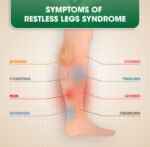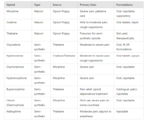Codeine works as an opioid analgesic and antitussive (cough suppressant), affecting both pain and cough pathways in the body. Codeine is from a group of medicines called opiates, or narcotics. It works in the central nervous system and the brain to block pain signals to the rest of the body.
It also reduces the anxiety and stress caused by pain.
When codeine blocks the pain, there are other unwanted effects, such as slow or shallow breathing. It also slows down digestion, which is why codeine can cause constipation.
Here’s how it works:
1. Pain Relief (Analgesic Action):
- Binding to Opioid Receptors: Codeine is a weak opioid, meaning it acts on the mu-opioid receptors in the brain and spinal cord. These receptors are part of the central nervous system’s pathway for pain sensation.
- Pain Signal Interruption: By binding to these receptors, codeine reduces the transmission of pain signals between nerve cells, effectively blunting the perception of pain. It doesn’t remove the source of pain but changes how the brain and body experience it, providing relief for moderate pain.
- Conversion to Morphine: Codeine is considered a prodrug, meaning it is inactive until metabolized. In the liver, enzymes (mainly CYP2D6) convert codeine into morphine, a more potent opioid. This morphine is responsible for the majority of codeine’s pain-relieving effects, although only a small percentage (5-10%) of codeine is converted to morphine.
2. Cough Suppression (Antitussive Action):
- Depression of Cough Reflex: Codeine works as a cough suppressant by acting on the cough center in the brain (specifically in the medulla). It raises the threshold for the cough reflex, making it less likely for the body to initiate coughing, even when the throat or airways are irritated.
- Effectiveness: This is particularly useful in treating persistent, non-productive coughs that have no immediate function (such as clearing mucus) but can cause discomfort or interrupt sleep.
3. Central Nervous System Effects:
- Euphoria and Sedation: In addition to relieving pain and suppressing coughs, codeine can cause euphoria and sedation by acting on the brain’s opioid receptors. This is why codeine has the potential for abuse, as it can create a feeling of well-being or relaxation when taken in higher doses.
- Respiratory Depression: Codeine, like other opioids, can also depress respiratory function by slowing the breathing rate. This effect is more dangerous at higher doses or when combined with other depressants (e.g., alcohol or benzodiazepines).
4. Metabolism Variability:
- Metabolism Differences: The effectiveness of codeine can vary significantly between individuals due to genetic differences in the CYP2D6 enzyme. People who are ultra-rapid metabolizers may convert more codeine into morphine than normal, leading to a higher risk of side effects or overdose. Conversely, poor metabolizers may find that codeine is less effective, as they produce little to no morphine from the drug.
Summary of How Codeine Works:
- Relieves Pain: By binding to opioid receptors, reducing the perception of pain.
- Suppresses Cough: By depressing the cough reflex in the brain.
- Metabolized into Morphine: Codeine is converted into morphine, which is primarily responsible for its effects.
- Affects CNS: Causes sedation, relaxation, and potentially euphoria, but also poses risks like respiratory depression, especially at higher doses.
Codeine’s mode of action makes it useful for managing moderate pain and coughing, but its effects on the central nervous system also account for the risks of misuse, tolerance, dependence, and overdose.
Pain Medications, Pain Relief, and Pain Management









eangl5
hxh1dv
po949i
d2nu4u